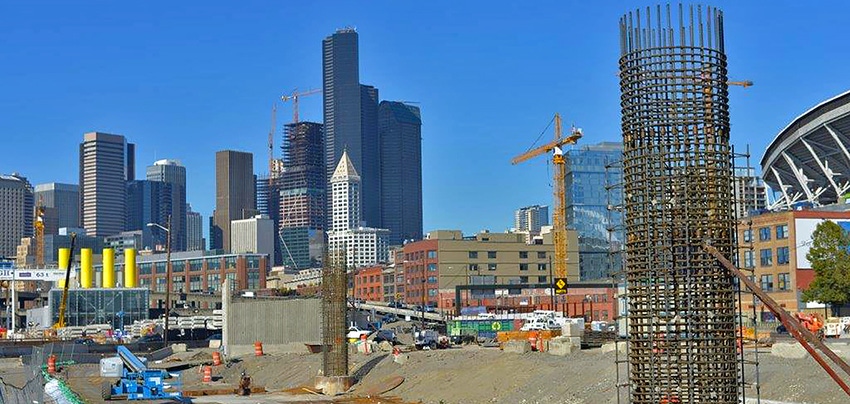Civil engineering professor and researcher Saiid Saiidi has pioneered technology that will help keep critical infrastructure open and usable following large earthquakes, and downtown Seattle is about to gain the first benefits.
December 17, 2016

Structural trauma caused by earthquakes can wreak havoc on roads and bridges, particularly when they are poorly engineered and constructed. Even in cases when bridges and overpasses avoid complete catastrophic collapse, they are often rendered unusable after large earthquakes, hampering the flow of traffic as well as rescue and rubble clearing efforts.
|
The two earthquake-resistant columns will support a new exit bridge ramp from downtown Seattle’s busy state route 99. (Image source: University of Nevada, Reno). |
At the University of Nevada, Reno, civil engineering professor and researcher Saiid Saiidi has pioneered technology that will help keep critical infrastructure open and usable following large earthquakes, and downtown Seattle is about to gain the first benefits. The technology – the result of 15 years of research – is currently being used in the construction of a new exit bridge ramp on a section of the busy State Route 99 corridor through downtown Seattle. The ramp, which is supported by special columns designed to shake and flex rather than collapse, even during a major earthquake, is scheduled to be completed in spring of 2017.
The materials are the most critical element of the design. Bridge columns made using memory-retaining nickel-titanium rods, or “Nitinol” – as opposed to steel rebar – and a flexible concrete composite were able to return to their original shape even after an earthquake as strong as a magnitude 7.5.
“The material used in the most critical part of the columns is unique because it’s not actually steel, unlike traditional rebar,” Saiidi said. “It’s made of an alloy of titanium (44 percent) and nickel (56 percent). The material is ‘smart’ because it remembers, as a shape memory alloy, its original shape. If you stretch it or compress it, it goes back to its original length once you let it go. teel cannot recover its elongation once it gets past certain limit.”
The concrete used in the project is known as “engineered cementitious concrete”, or ECC. While it’s not accurate to call it “smart concrete,” it’s still special in its composition.
“The concrete is still superior to ordinary concrete because of its high tensile strain capacity that prevents it from falling apart under back and forth action of earthquakes,” Saiidi said. “There are polyvinyl fibers in the concrete with special coating that control cracking and maintain the integrity of the material.”
Since he began his research, Professor Saiidi has experimented with a variety of combinations of materials to replace traditional concrete and steel rebar materials as well as traditional designs. In his “earthquake simulation lab” at the University of Nevada, Reno, he has built and destroyed 200-ton bridges, bridge columns, and concrete abutments. So how do you simulate an earthquake in a lab? Computer-controlled hydraulics allow the lab to simulate earthquakes of various intensities to test new materials.
“We use shake tables that are able to simulate earthquakes,” Professor Saiidi told Design News. “We typically use the recorded motions from previous earthquakes and duplicate them in the lab.”
An experiment conducted last year in the lab moved a test bridge more than six inches off center at the base, after which it returned to its original position, even at 250 percent of earthquake intensity past the design parameters.
The combination of Nitinol and ECC is what makes the overpass columns unique. The new materials are not used throughout the entire column, but only where they are needed. During strong earthquakes, it’s the column end regions that are the most critical, and this is where the technology is implemented.
“In critical zones of columns, we have to resort to unconventional material that are different from steel and concrete,” Saiidi said. “We can use steel and concrete in the rest of the bridge because they are cost-effective.”
By using Nitinol and ECC only in strategic parts of the support columns, the technology is affordable: Saiidi estimates increased costs of between 5 to 10 over traditional materials. Ultimately, the goal of the research is to progress from “no collapse” to “no damage.” This may involve the use of more unconventional materials, including other shape memory alloys (SMAs), rubber or fiber-reinforced polymers with glass or carbon fibers. One of the emerging SMA types is made with copper, aluminum, and manganese, and Saiidi is currently working with Japanese collaborators to develop and implement them for research and eventually construction.
Pacific Design & Manufacturing 2017 | Registration is open! Pacific Design & Manufacturing connects you with over 20,000 engineers and executives, as well as hundreds of leading suppliers, across the advanced design and manufacturing spectrum who understand the value in working together on the industry’s cutting edge. Register Today! |
“We will continue our research on using smart materials for precast bridge members so they can help shorten construction time,” he said. “This is accelerated bridge construction, or ABC. We’re also working on modular elements that can be replaced.”These new materials could bring costs down even further, as the new alloys are 80 to 90 percent less expensive than Nitinol. Saiidi also said that his lab also hopes to shorten construction times using the new materials.
Tracey Schelmetic graduated from Fairfield University in Fairfield, Conn. and began her long career as a technology and science writer and editor at Appleton & Lange, the now-defunct medical publishing arm of Simon & Schuster. Later, as the editorial director of telecom trade journal Customer Interaction Solutions (today Customer magazine) she became a well-recognized voice in the contact center industry. Today, she is a freelance writer specializing in manufacturing and technology, telecommunications, and enterprise software.
About the Author(s)
You May Also Like





